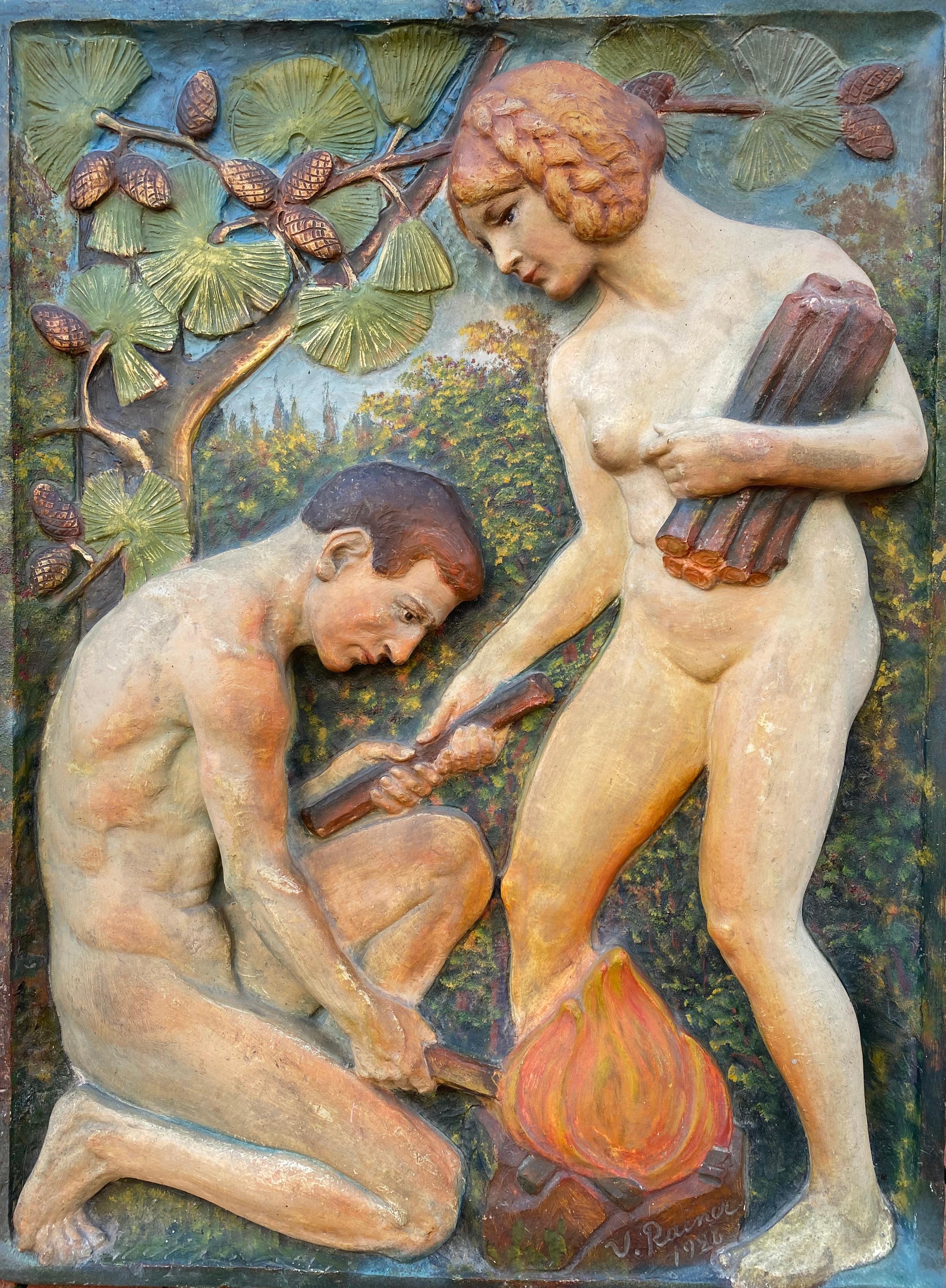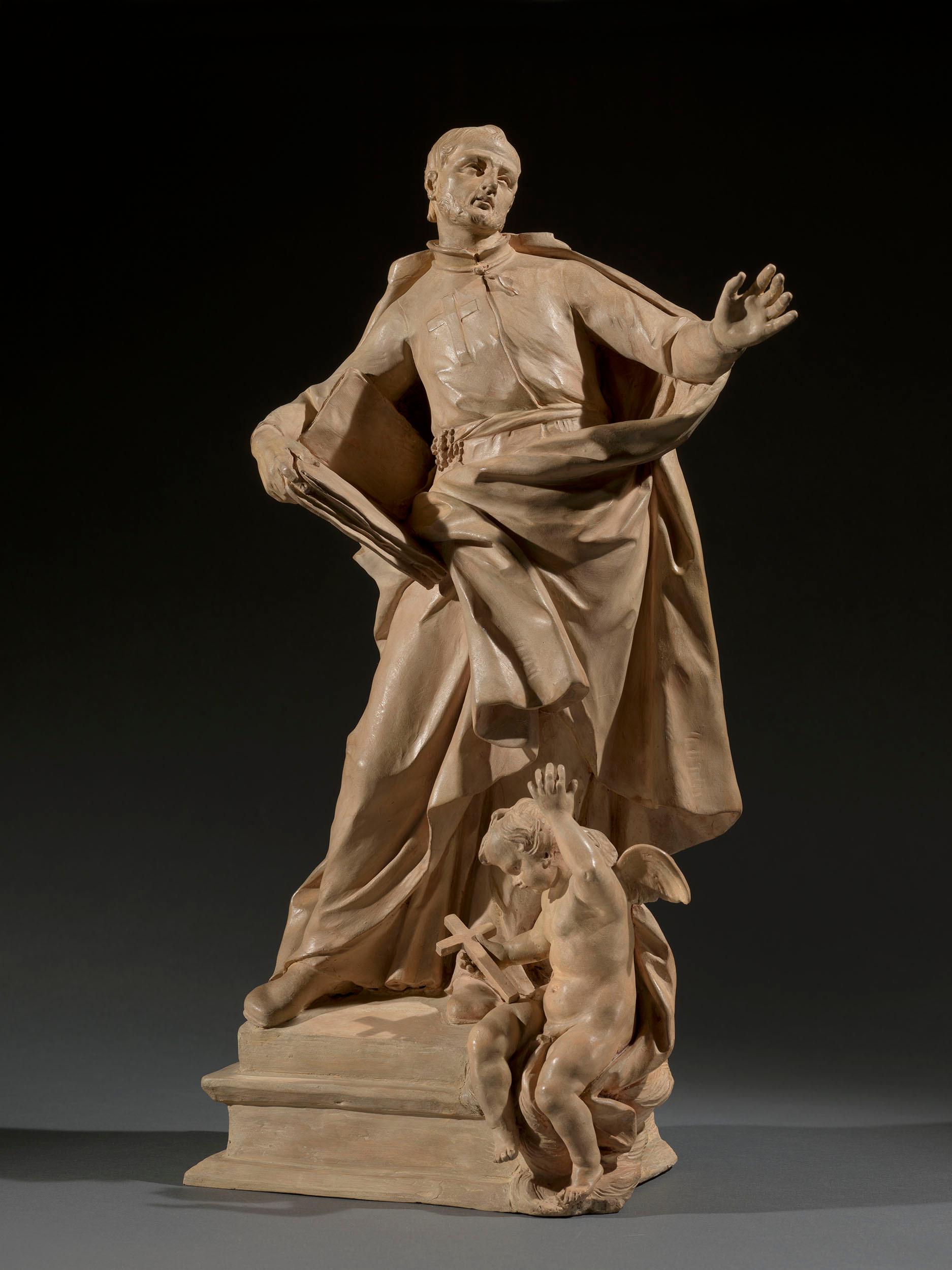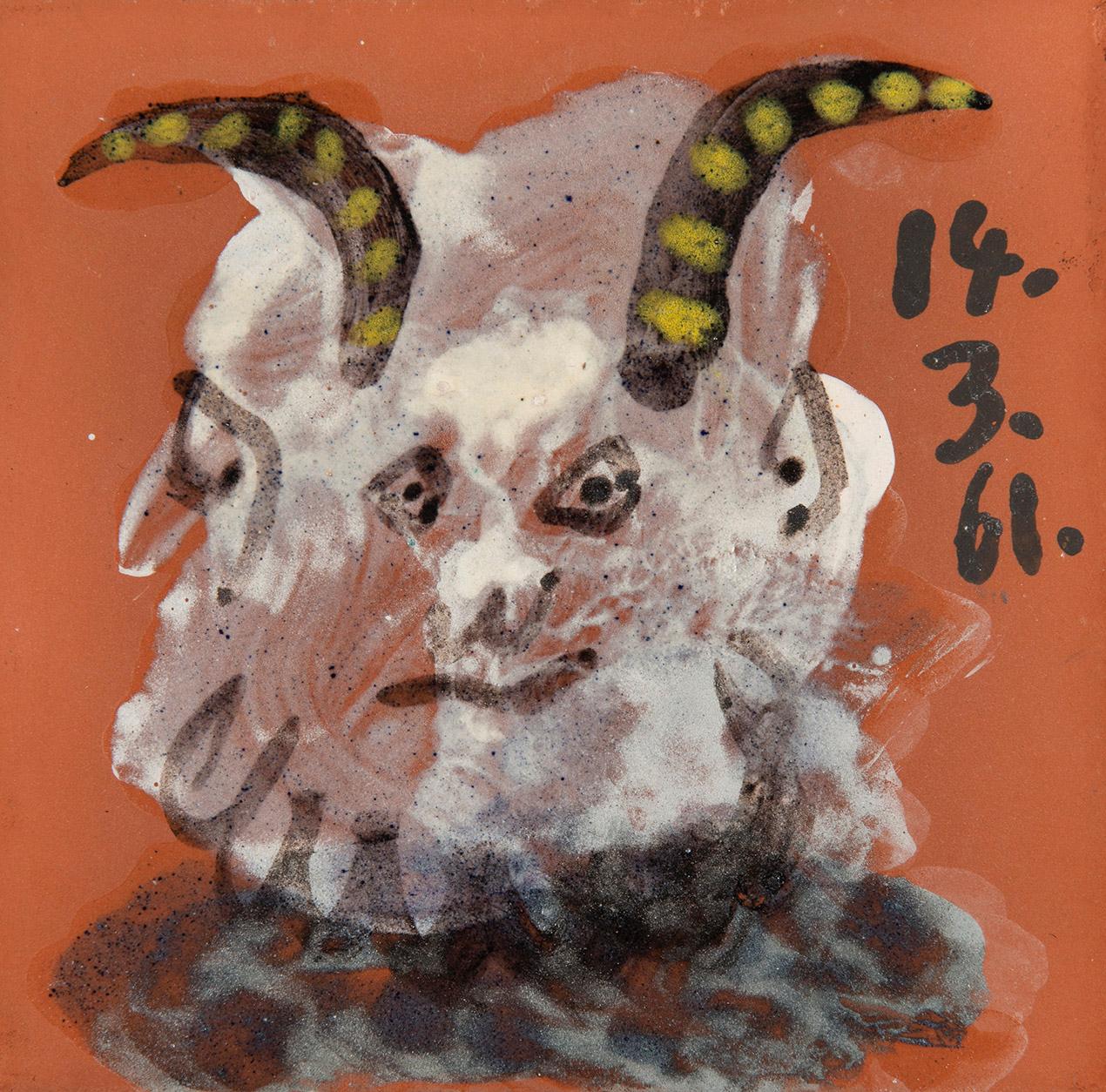Items Similar to Head of a Young African Man
Want more images or videos?
Request additional images or videos from the seller
Italian School, ca. 1800Head of a Young African Manca. 1800
ca. 1800
About the Item
Provenance: Private Collection, Spain.
This intriguing and enigmatic sculpture depicts the head of a young African man emerging from a circular opening or window. He is seen in three-quarter profile, his eyes partially closed, but with a resolute expression punctuated by his surging hair. He seems neither an allegorical figure, nor an ethnographic type. Were it not for the highly unusual format, the specificity of his features would suggest that he is the subject of a portrait. The function of the work remains a mystery. Its scale, material, and degree of finish suggest that it was a model for a larger work—whether an architectural ornament, an element of a multi-figure composition, a funerary or commemorative monument, or some grand sculptural project.
As an individual head seen in isolation it seems to evoke a range of associations—resignation, resistance, solitude. And the visual ties to images of the head of Saint John the Baptist on a salver, whether or not intended by the artist, gives additional resonance to the piece. The octagonal surround as well as the inner frame are integral with the head, and as the work does not correspond to any familiar class of object—whether artistic, decorative, or utilitarian—it seems likely that our sculpture could have been retained in the studio of the unknown artist who modeled it. On the basis of its high quality and style, we have suggested that it is Italian of the late 18th or early 19th century, but as with its purpose, its origin and date remain to be discovered, although its beauty can be appreciated despite the lack of art-historical context.
- Creator:Italian School, ca. 1800 (Italian)
- Creation Year:ca. 1800
- Dimensions:Height: 9 in (22.86 cm)Width: 8.625 in (21.91 cm)
- Medium:
- Period:
- Condition:
- Gallery Location:New York, NY
- Reference Number:1stDibs: LU10212237532

About the Seller
5.0
Recognized Seller
These prestigious sellers are industry leaders and represent the highest echelon for item quality and design.
Established in 1997
1stDibs seller since 2012
17 sales on 1stDibs
Typical response time: 11 hours
- ShippingRetrieving quote...Ships From: New York, NY
- Return PolicyThis item cannot be returned.
More From This SellerView All
- Portrait of Ni-PologLocated in New York, NYSigned, dated, and inscribed on the verso: Malvina Hoffman/ Den Pasar/ “Nipolog”-/ © 1932/ Bali Provenance: The artist; her estate. Literature: Mal...Category
1930s Realist Sculptures
MaterialsTerracotta
- The Story of Joseph from the Second Baptistery Doors, Florence (“The Gates of PaBy Ferdinand BarbedienneLocated in New York, NYFerdinand Barbedienne (Saint-Martin-de-Fresnay 1810 – 1892 Paris) after Lorenzo Ghiberti (Florence, 1378 – 1455) Signed at the lower right of the principal relief: F. BARBEDIENNE Provenance: Private Collection, USA. Barbedienne’s “Gates of Paradise” reliefs are one of the triumphs of nineteenth-century bronze casting and patination. The nine panels that comprise our example are half-size reductions of the famous originals by Lorenzo Ghiberti, made for the Baptistery of Florence and now housed in the Museo del Opera del Duomo. Mounted in an impressive, mullioned frame surround, our work is an exceptional exemplar of the Renaissance Revival, the broadly influential style and movement that infused architecture, design, and artistic culture in the latter half of the nineteenth century. The central scene, The Story of Joseph, is perhaps the most celebrated of the entire series depicting as it does seven episodes from the Biblical narrative integrated into a single composition: Joseph cast by his brethren into the well, Joseph sold to the merchants, the merchants delivering Joseph to the pharaoh, Joseph interpreting the pharaoh’s dream, the pharaoh paying him honor, Jacob sending his sons to Egypt, and Joseph recognizes his brothers and returns home. The surrounding reliefs—two vertical figures in niches, two recumbent figures, and four portrait heads in roundels—are as well faithful reductions of Ghiberti’s original bronzes on other parts of the doors. The maker of these casts was the renowned 19th-century French fondeur Ferdinand Barbedienne. Gary Radke has recently written of this great enterprise: “The Parisian bronze caster Ferdinand Barbedienne began making half-sized copies of ancient and Renaissance sculpture in the 1830s. His firm benefitted enormously from the collaboration of Achille Collas, whom Meredith Shedd has shown was one of numerous pioneers in the mechanical reproduction of sculpture. Their competitors largely devoted themselves to reproducing relief sculpture, but Collas devised a process for creating fully three-dimensional copies. A tracing needle, powered by a treadle, moved over the surface of a full-sized plaster cast or bronze of the original and triggered a complementary action in a cutting stylus set over a soft plaster blank…He signed an exclusive contract with Barbedienne on November 29, 1838, and won medals for his inventions in 1839 and 1844. Barbedienne’s half-sized copies of the Gates of Paradise were famous not only for their fidelity to the original, but also for the way their gilding…suggested the glimmering surface that was hidden under centuries of dirt. Some critics even saw Collas’s and Barbedienne’s work as ‘philanthropic, an exemplary adaptation of industry to the requirements of art, the artist, the workers, and the public alike.’ At 25,000 francs, Collas’s and Barbedienne’s reduction of the Gates of Paradise was singularly more expensive than any other item for sale in their shop. All the reliefs, individual statuettes, and busts were cast separately and could be purchased either by the piece or as an ensemble. Fittingly, Barbedienne’s accomplishment earned him the Grand Prix at the 1878 Paris Exposition Universelle, along with numerous other medals.” Three complete examples of the Barbedienne-Ghiberti doors are known. One, first installed in a chapel in the Villa Demidoff of San Donato near Pratolino, was later acquired by William Vanderbilt...Category
Late 19th Century Figurative Sculptures
MaterialsBronze
- The Three MagiLocated in New York, NYProvenance: Private Collection, Spain. Known as Peruvian alabaster for its translucency and workability, Piedra de Huamanga is a highly prized material from the province of Ayacucho in Peru. In the 17th and 18th centuries, local craftsman in the town of Huamanga began to specialize in the production of small-scale, polychrome religious sculptures made from this distinctive stone. Huamanga sculptures are among the most accomplished examples of carving from the Spanish Americas, where polychrome wood sculpture was a far more common sculptural medium. These works, which were created as independent sculptures or as sculptural groups—such as our three Magi—were intended for ecclesiastical as well as domestics settings. Our three figures likely formed part of a larger Nativity group—a New World variant of the tradition of the Neapolitan Crèche...Category
Late 18th Century Figurative Sculptures
MaterialsAlabaster
- A Guardian Angel and a ChildLocated in New York, NYProvenance: Cornelius Vanderbilt, New York; by whom gifted in 1880 to: The Metropolitan Museum of Art, New York (80.3.673); deaccessioned and sold: Christie’s, New York, 12 June 19...Category
17th Century Old Masters Portrait Paintings
MaterialsTerracotta, Gesso
- Moroccan, Fez or Meknes: Tall bowl (Jobbana) with geometric designsLocated in New York, NYProvenance: Collection of Emily Johnston De Forest and Robert Weeks De Forest, New York, by 1911-until 1942; thence by descent until 2018. Literature: ...Category
1810s Sculptures
MaterialsTin Glaze, Earthenware
- Cuzco School Baptismal DishBy Spanish Colonial (Peruvian)Located in New York, NYProvenance: Manuel Ortíz de Zevallos y García, Peru; and by descent in the family to: Private Collection, New York. This impressive baptismal dish is an example of eighteenth-cent...Category
18th Century Old Masters Sculptures
MaterialsSilver
You May Also Like
- The TrapdoorBy Arturo MartiniLocated in Roma, RMArturo Martini (Treviso 1889 - Milan 1947), La Botola (1930 / 1933) Terracotta sculpture 34 x 42 x 9 cm signed lower left; label of Galleria del Milione, Milan, on back. Provenance...Category
1930s Italian School Figurative Sculptures
MaterialsTerracotta
- “Adam and Eve”Located in Southampton, NYVery rare Art Deco three dimensional terracotta sculpture of Adam and Eve by the Austrian artist, Virgil Rainer. Hand painted by the artist. Signed bott...Category
1920s Art Deco Figurative Sculptures
MaterialsTerracotta, Plaster
- Roman 18th century terracotta model for the sculpture of San Camillo de LellisLocated in London, GBThis remarkably fluid terracotta bozetto was made in preparation for Pietro Pacilli’s most important public commission, a large-scale marble statue of San Camillo de Lellis for the nave of St Peter’s Basilica in Rome. Expressively modelled, this terracotta sculpture is a rare and significant work made by a major Roman sculptor at a transformative moment of European sculpture. Pacilli began his working life on the great Baroque decorative projects initiated in the seventeenth century, but he found success as a restorer of ancient sculpture working to finish antiquities for a tourist market, becoming an important figure in the emergence of an archaeologically minded Neoclassicism. Pacilli trained Vincenzo Pacetti and provided important decorative work for the Museo Pio-Clementino, at the same time he is recorded restoring some of the most celebrated antiquities excavated and exported during the period. Pacilli was born into a family of Roman craftsmen, his father Carlo was a wood carver, and Pacilli is recorded working with him on the Corsini Chapel in San Giovanni Laternao as early as 1735. In 1738 his terracotta model of Joseph and Potiphar’s Wife won the first prize in the second class of the sculpture concorso at the Accademia di San Luca, this is particularly notable as Bartolomeo Cavaceppi came third. He worked as a carver and stuccoist completing works for the churches of San Marco and SS. Trinita dei Domeniciani Spagnoli. Pacilli operated as a sculptor and restorer of antiquities from his studio at the top of the Spanish Steps, close to Santa Trinita dei Monti, where he is listed as a potential vendor to the Museo Pio-Clementino in 1770. In 1763 Pacilli completed a silver figure of San Venanzio for the treasury of San Venanzio. He is recorded as Pacetti’s first master and it was evidently through Pacilli that he began to acquire his facility as a restorer of ancient sculpture. Pacilli, at his studio ‘poco prima dell’Arco della Regina alla Trinita dei Monti,’ exercised, what the nineteenth-century scholar, Adolf Michaelis called ‘rejuvenating arts’ on several important pieces of classical sculpture, including in 1760 the group of a Satyr with a Flute for the natural brother of George III, General Wallmoden, Hanovarian minister at Vienna. In 1765, Dallaway and Michaelis record that Pacilli was responsible for the restorations, including the addition of a new head, to the Barberini Venus which he had acquired from Gavin Hamilton. The Venus was then sold to Thomas Jenkins, who in turn passed it on to William Weddell at Newby Hall. In 1767 Pacilli exported a series of ancient busts ‘al naturale’ including portraits of Antinous, Julius Ceaser and Marus Aurelius, also a statue of a Muse and a Venus. As early as 1756 Pacilli seems to have been operating as an antiquarian, helping to disperse the collection of the Villa Borrioni. Pacilli supplied sculpture to notable British collectors, including Charles Townley, who on his first trip to Italy purchased the Palazzo Giustiniani statue of Hecate from Pacilli. Pacilli was involved with the Museo Pio Clementino from its conception, supplying busts of Julius Ceaser and a Roman Woman as well as completing stucco putti surmounting the arms of Pope Bendedict XIV to signal the entrance to the new Museo Critiano. In 1750 Il Diario Ordinario del Chracas announced that Pacilli had begun work on a sculpture of San Camillo de Lellis for St Peter’s. Camillo de Lellis founded his congregation, the Camillians, with their distinctive red felt crosses stitched on black habits in 1591. Having served as a soldier in the Venetian army, Camillo de Lellis became a novitiate of the Capuchin friars, he moved to Rome and established a religious community for the purpose of caring for the sick. In 1586 Pope Sixtus V formerly recognised the Camillians and assigned them to the Church of Santa Maria Maddalena in Rome. Camillo de Lellis died in 1614 and was entombed at Santa Maria Maddalena, he was canonised by Benedict XIV on June 26, 1746. It was an occasion that prompted the Camillians to make a number of significant artistic commissions, including two canvases by Pierre Subleyras showing episodes from San Camillo’s life which they presented to Benedict XIV. In 1750 Pacilli was commissioned to fill one of the large niches on the north wall of the nave with a sculpture of San Camillo. The present terracotta bozetto presumably had two important functions, to enable Pacilli to work out his ideas for the finished sculpture and at the same time to show his design to the various commissioning bodies. In this case it would have been Cardinal Alessandro Albani and Monsignor Giovan Francesco Olivieri, the ‘economo’ or treasurer of the fabric of St Peter’s. Previously unrecorded, this terracotta relates to a smaller, less finished model which has recently been identified as being Pacilli’s first idea for his statue of San Camillo. Preserved in Palazzo Venezia, in Rome, the terracotta shows San Camillo with his left hand clutching his vestments to his breast; the pose and action more deliberate and contained than the finished sculpture. In producing the present terracotta Pacilli has expanded and energised the figure. San Camillo is shown with his left hand extended, his head turned to the right, apparently in an attempt to look east down the nave of St Peter’s. The model shows Pacilli experimenting with San Camillo’s costume; prominently on his breast is the red cross of his order, whilst a sense of animation is injected into the figure through the billowing cloak which is pulled across the saint’s projecting right leg. The power of the restrained, axial contrapposto of bent right leg and outstretched left arm, is diminished in the final sculpture where a baroque fussiness is introduced to the drapery. What Pacilli’s terracotta demonstrates, is that he conceived the figure of San Camillo very much in line with the immediate tradition of depicting single figures in St Peter’s; the rhetorical gesture of dynamic saint, arm outstretched, book in hand, head pointed upwards was perhaps borrowed from Camillo Rusconi’s 1733 sculpture of St. Ignatius...Category
18th Century Baroque Figurative Sculptures
MaterialsTerracotta
- Medusa and AndromedaBy Magdeburger Kunstwerkstatten Reps and TrinteLocated in West Hollywood, CAMedusa and Andromeda, is a unique three dimensional terra cotta sculpture/vase, created by the German firm Magdeburger Kunstwerkstatten, Reps and Trinte, a studio that specialized in fine works in terra cotta. This monumental piece depicts the entire story of the Medusa, who holds Andromeda captive by chaining her to rocks in the ocean. You can see the chains at her wrists and ankles. Medusa charges the Leviathan (dragon) as guard over the captive Andromeda. Andromeda was rescued by her future husband Perseus who killed the dragon and saved his future bride. This is one of the most unique works of its kind that has been seen to date. It was probably a sculpture/vase designed and created for presentation at one of the yearly Salon exhibitions in Europe. We have consulted experts in European ceramics...Category
Early 1900s Figurative Sculptures
MaterialsTerracotta
- Tête de Faune, Picasso, Unique work, 1960's, Terracotta, Tiles, Design, SculpturBy Pablo PicassoLocated in Geneva, CHTête de Faune, Picasso, Unique work, 1960's, Terracotta, Tiles, Design, Sculptur Tête de faune Unique work 14.03.1961 Painted and glazed terracotta tile...Category
1960s Post-War Figurative Sculptures
MaterialsTerracotta
- Tête de Faune, Pablo Picasso, Unique piece, Design, Terracotta, Tile, MythologyBy Pablo PicassoLocated in Geneva, CHTête de Faune, Pablo Picasso, Unique piece, Design, Terracotta, Tile, Mythology Tête de faune Unique work 08.08.1956 Painted and glazed terracotta tile...Category
1950s Post-War Figurative Sculptures
MaterialsCeramic, Earthenware, Terracotta





